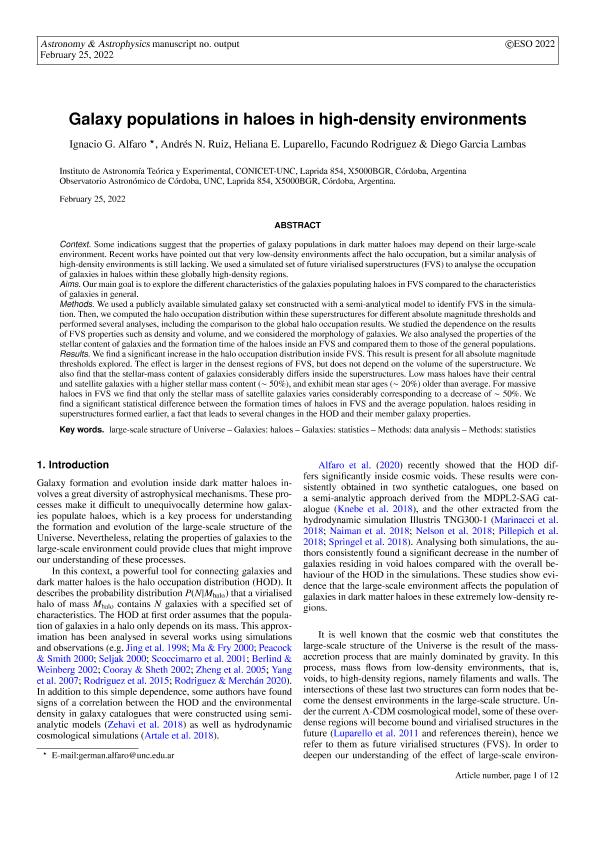Artículo
Galaxy populations in haloes in high-density environments
Alfaro, Ignacio Germán; Ruiz, Andrés Nicolás ; Luparello, Heliana Estefanía
; Luparello, Heliana Estefanía ; Rodriguez, Facundo
; Rodriguez, Facundo ; Garcia Lambas, Diego Rodolfo
; Garcia Lambas, Diego Rodolfo
 ; Luparello, Heliana Estefanía
; Luparello, Heliana Estefanía ; Rodriguez, Facundo
; Rodriguez, Facundo ; Garcia Lambas, Diego Rodolfo
; Garcia Lambas, Diego Rodolfo
Fecha de publicación:
10/2021
Editorial:
EDP Sciences
Revista:
Astronomy and Astrophysics
ISSN:
0004-6361
e-ISSN:
1432-0746
Idioma:
Inglés
Tipo de recurso:
Artículo publicado
Clasificación temática:
Resumen
Context. Some indications suggest that the properties of galaxy populations in dark matter haloes may depend on their large-scale environment. Recent works have pointed out that very low-density environments affect the halo occupation, but a similar analysis of high-density environments is still lacking. We used a simulated set of future virialised superstructures (FVS) to analyse the occupation of galaxies in haloes within these globally high-density regions. Aims. Our main goal is to explore the different characteristics of the galaxies populating haloes in FVS compared to the characteristics of galaxies in general. Methods. We used a publicly available simulated galaxy set constructed with a semi-Analytical model to identify FVS in the simulation. Then, we computed the halo occupation distribution within these superstructures for different absolute magnitude thresholds and performed several analyses, including the comparison to the global halo occupation results. We studied the dependence on the results of FVS properties such as density and volume, and we considered the morphology of galaxies. We also analysed the properties of the stellar content of galaxies and the formation time of the haloes inside an FVS and compared them to those of the general populations. Results. We find a significant increase in the halo occupation distribution inside FVS. This result is present for all absolute magnitude thresholds explored. The effect is larger in the densest regions of FVS, but does not depend on the volume of the superstructure. We also find that the stellar-mass content of galaxies considerably differs inside the superstructures. Low mass haloes have their central and satellite galaxies with a higher stellar mass content (∼50%), and exhibit mean star ages (∼20%) older than average. For massive haloes in FVS we find that only the stellar mass of satellite galaxies varies considerably corresponding to a decrease of ∼50%. We find a significant statistical difference between the formation times of haloes in FVS and the average population. haloes residing in superstructures formed earlier, a fact that leads to several changes in the HOD and their member galaxy properties.
Archivos asociados
Licencia
Identificadores
Colecciones
Articulos(IATE)
Articulos de INST.DE ASTRONOMIA TEORICA Y EXPERIMENTAL
Articulos de INST.DE ASTRONOMIA TEORICA Y EXPERIMENTAL
Citación
Alfaro, Ignacio Germán; Ruiz, Andrés Nicolás; Luparello, Heliana Estefanía; Rodriguez, Facundo; Garcia Lambas, Diego Rodolfo; Galaxy populations in haloes in high-density environments; EDP Sciences; Astronomy and Astrophysics; 654; A62; 10-2021; 1-12
Compartir
Altmétricas



